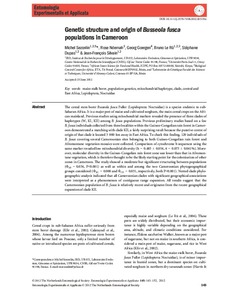| dc.contributor.author | Sezonlin, M. |
| dc.contributor.author | Ndemah, R. |
| dc.contributor.author | Goergen, Georg E. |
| dc.contributor.author | Le Rü, B. |
| dc.contributor.author | Dupas, S. |
| dc.contributor.author | Silvain, J. |
| dc.date.accessioned | 2019-12-04T11:08:20Z |
| dc.date.available | 2019-12-04T11:08:20Z |
| dc.date.issued | 2012-11 |
| dc.identifier.citation | Sezonlin, M., Ndemah, R., Goergen, G., Le Rü, B., Dupas, S. & Silvain, J. (2012). Genetic structure and origin of Busseola fusca populations in Cameroon. Entomologia Experimentalis et Applicata, 145(2), 143-152. |
| dc.identifier.issn | 0013-8703 |
| dc.identifier.uri | https://hdl.handle.net/20.500.12478/1799 |
| dc.description.abstract | The cereal stem borer Busseola fusca Fuller (Lepidoptera: Noctuidae) is a species endemic to sub-Saharan Africa. It is amajor pest ofmaize and cultivated sorghum, the main cereal crops on the African mainland. Previous studies using mitochondrial markers revealed the presence of three clades of haplotypes (W, KI, KII) among B. fusca populations. Previous preliminary studies based on a few B. fusca individuals collected fromthree localities within the Guineo-Congolian rain forest in Cameroon demonstrated a matching with clade KII, a fairly surprising result because the putative centre of origin of that clade is located 3 000 km away in East Africa. To check this finding, 120 individuals of B. fusca covering several Cameroonian sites belonging to both Guineo-Congolian rain forest and Afromontane vegetation mosaics were collected. Comparison of cytochrome b sequences using the
samemarker revealed low mitochondrial diversity (h = 0.483 ± 0.054, p = 0.073 ± 0.061%).Moreover, molecular diversity in the Guineo-Congolian rain forest zone was lower than that in Afromontane vegetation, which is therefore thought to be the likely starting point for the colonization of other zones in Cameroon. The study showed a moderate but significant structuring between populations (ΦST = 0.034, P<0.001) as well as within and among the two Cameroonian phytogeographical groups considered (ΦSC = 0.000 and ΦCT = 0.051, respectively, both P<0.001). Nested clade phylogeographic analysis indicated that all Cameroonian clades with significant geographical associations were interpreted as a phenomenon of contiguous range expansion. All results suggest that the Cameroonian population of B. fusca is relatively recent and originates from the recent geographical
expansion of clade KII. |
| dc.description.sponsorship | International Foundation for Science |
| dc.format.extent | 143-152 |
| dc.language.iso | en |
| dc.subject | Maize Stalk Borer |
| dc.subject | Population Genetics |
| dc.subject | Mitochondrial Haplotype |
| dc.subject | Clade |
| dc.subject | Central And East Africa |
| dc.subject | Lepidoptera |
| dc.subject | Noctuidae |
| dc.title | Genetic structure and origin of Busseola fusca (Fuller) (Lepidoptera, Noctuidae) populations in Cameroon |
| dc.type | Journal Article |
| dc.description.version | Peer Review |
| cg.contributor.crp | Integrated Systems for the Humid Tropics |
| cg.contributor.affiliation | Institut de Recherche pour le De´veloppement |
| cg.contributor.affiliation | Université de Paris-Sud |
| cg.contributor.affiliation | International Centre of Insect Physiology and Ecology |
| cg.contributor.affiliation | International Institute of Tropical Agriculture |
| cg.contributor.affiliation | Université d'Abomey Calavi |
| cg.coverage.region | Africa |
| cg.coverage.region | West Africa |
| cg.coverage.country | Cameroon |
| cg.isijournal | ISI Journal |
| cg.authorship.types | CGIAR and developing country institute |
| cg.iitasubject | Pests Of Plants |
| cg.iitasubject | Maize |
| cg.journal | Entomologia Experimentalis et Applicata |
| cg.howpublished | Formally Published |
| cg.accessibilitystatus | Limited Access |
| local.dspaceid | 83251 |
| cg.identifier.doi | http://dx.doi.org/10.1111/j.1570-7458.2012.01319.x |

